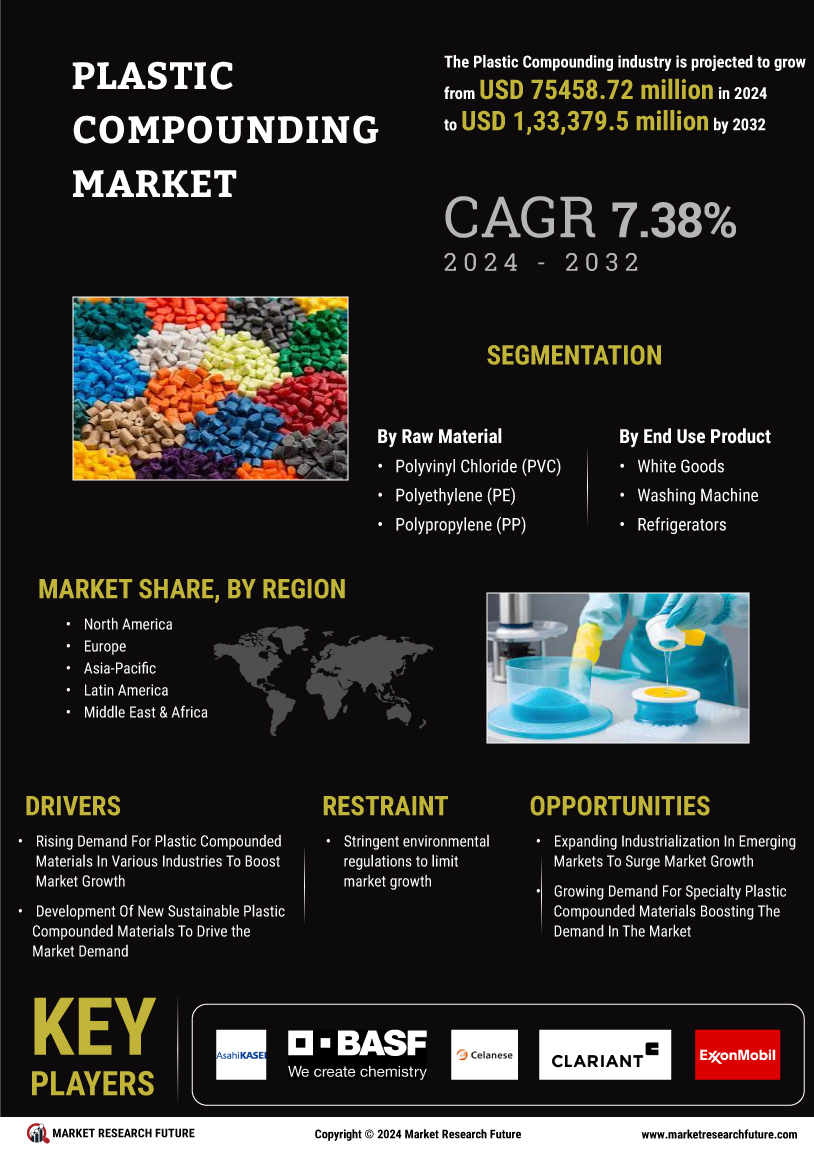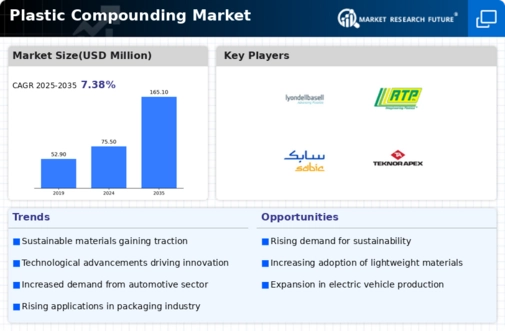RISING DEMAND FOR PLASTIC COMPOUNDED MATERIALS IN VARIOUS INDUSTRIES TO BOOST MARKET GROWTH
The growing demand for plastic compounded End-Use Products across many industries is driving a significant upswing in the plastic compounding market. This increase can be ascribed to the remarkable qualities and adaptability that plastic compounds provide, which make them essential in a variety of applications. This increasing demand has been largely driven by the automobile, construction, consumer goods, electronics, and packaging industries. The need for strong, lightweight materials in the automotive industry has propelled the expansion of the plastic compounding market.
Plastic compounds can reduce vehicle weight, increase fuel efficiency, and improve overall performance, making them an appealing substitute for conventional components like metal and glass. The need for plastic compounded materials is further increased by the usage of these compounds in electrical systems, exteriors, under-the-hood applications, and interior components. A further significant factor driving the plastic compounding market's growth is the building sector. In construction, plastic compounds are widely used in materials for flooring, roofing, insulation, piping, and fittings.
In the building industry, plastic compounds are favored due to their advantages in terms of weather resistance, durability, affordability, and convenience of installation. The requirement for plastic compounded materials to fulfill the various needs of the construction industry is increasing because of the growing global building activity. Consumer goods makers are also using plastic compounds more frequently to improve the looks and quality of their End-Use Products. These materials provide exceptional design flexibility, enabling the creation of complex forms and eye-catching colors—both essential for producing aesthetically pleasing consumer goods.
Toys, sporting goods, furniture, and household appliances are just a few of the consumer End-Use Products that require plastic compounds.
In May 2024, today Cabot Corporation (NYSE: CBT) announced that they have launched their new universal circular black masterbatches, REPLASBLAK®, which are made from certified sustainable material. These two products are the first of their kind in the industry as they are universal circular black masterbatches and contain International Sustainability & Carbon Certification (ISCC PLUS) certified content. The new REPLASBLAK universal circular black masterbatches have been formulated with EVOLVE® Sustainable Solutions, allowing Cabot to maintain the plastics industry’s performance levels, quality, and reliability while addressing certified circular solutions on a large scale.
Advanced sustainable solutions are supporting a circular economy and decreasing greenhouse gas emissions to transition globally toward a lower carbon future.
DEVELOPMENT OF NEW SUSTAINABLE PLASTIC COMPOUNDED MATERIALS TO DRIVE THE MARKET DEMAND
A primary motivation for the creation of sustainable plastic composite materials is the pressing requirement to reduce plastic pollution and its detrimental effects on the environment. The environmental endurance of conventional plastics is well-known since it contributes to contamination in rivers, landfills, and oceans. As a result, producers are putting more effort into developing biodegradable or compostable sustainable plastic components, which will prevent them from remaining in the environment and causing pollution. The market for plastic compounding is expanding as a result of this move toward biodegradable plastics.
It is one element of the brand’s sustainability plan, which, besides decreasing fossil-driven energy use, emissions, and landfill waste, enhances both health and safety within and outside an organization.
EXPANDING INDUSTRIALIZATION IN EMERGING MARKETS TO SURGE MARKET GROWTH
The growing wave of industrialization in emerging nations is the main driver of the impending significant rise in the plastic compounding market. There is a growing need across multiple industries for plastic compounded materials due to the fast industrialization of countries in regions like Asia, Latin America, and parts of Africa. Plastic compounds are essential to industrial processes due to their adaptability, affordability, and variety of uses; as a result, the plastic compounding market is leading this industrial revolution.
Emerging markets are pushing the need for plastic compounded materials to previously unheard-of heights, with a focus on consumer goods, packaging, automobile End-Use Production, infrastructure development, and more. The growing automobile sector is one of the main factors propelling the plastic compounding market in emerging regions. The demand for cars is rising significantly as a result of urbanization and rising disposable incomes. For automobile components, plastic compounds are a preferred option because of their simplicity of manufacture, durability, and lightweight. These components are essential for lowering a car's overall weight, increasing fuel economy, and fulfilling strict pollution regulations.
The need for plastic compounded materials is rising significantly as emerging nations seek to fulfill the demands of their expanding populations by continuing to increase their car manufacturing.
The ongoing evolution of the global plastic compounding market suggests a robust demand driven by advancements in material science and increasing applications across various industries.
U.S. Department of Commerce














